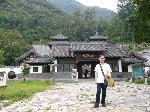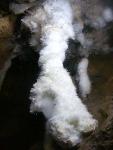- Getting around Lijiang. Dont stay in the Old Towns more than 2 days, there is nothing to do. KRISS Oct 9, 2013 05:46
- 2013 Beijing Temple Fair BENNYLAU Feb 26, 2013 03:29
- Malaysian traveling from KUL - LAX vis Shanghai PVG ZATI_DY Jan 3, 2013 20:15
Into the Fox's Den - The Silver Fox Cave
- Views: 4885
- |Vote: 0 0
- |Add to Favorites
- |Recommend to Friends
Daytripper
I'm always on the hunt for those kinds of special places that most other people don't know about, haven't heard of, or otherwise just wouldn't know how to find. For that reason, I could probably quite happily spend the rest of my life in China: this country is so huge you'd need a travel guide the size of an encyclopaedia to cover everywhere interesting, and you could visit somewhere new and intriguing every day until you died and still not have seen half of what China has to offer.
I've recently been writing for an annual called the Beijing Excursions Guide - a publication that reviews sites outside of the Beijing central city area and focuses on locations that could be visited in a day or a weekend. Not only has it given me the excuse to get out of the capital on smoggier days, but it's also given me a number of red-hot tips for a few extra excursions of my own. It was in this publication that I read of the Silver Fox Cave - a deep network of natural caves in Beijing's Fangshan District, about a two and a half hour bus ride to the south - and decided to go to explore.
The cave is a relatively new discovery, remaining undisturbed for a full four billion years until 1991, when some coal miners dug into it and figured it would make a good place to dump refuse. It was only a matter of time before it would have come to light: Fangshan's Xiayingshui village is full of mines and rock-breaking yards - it's a rough district set amongst the peculiar mountain formations of southern Beijing Municipality, and many of the cliffsides are cut away for stone materials. On this occasion the miners had unearthed what they figured was a small pocket of underground space, but when the scraps they tossed inside failed to fill up the hole as expected, they realised that it must be larger than was immediately obvious and started to explore. They were quite correct: the caves went down to more than a hundred metres beneath the soil, and stretched into a labyrinth of caverns filled with peculiar rock formations. Concealed right at the bottom flows a freshwater underground river. The surprised miners had stumbled upon a geological wonder and a national treasure, and their discovery is now the main source of income for the town, as daily bus tours carry enthusiastic local Chinese holidaymakers who have come to see the cave's most extraordinary attraction - a large crystalline structure within known as the Silver Fox.
3000 metres of cave is now open to tourists, as well as another 1000 metres along the river - a further 1000 metres have been explored, but are not yet accessible to the public, and more of the cave network is being discovered as time goes on - it's difficult to tell just how far they go. What clinched it for me, though, was the claim that the caves stay at 13 degrees Celsius all year round - given Beijing's recent hot weather, a trip through a literally cool cave sounded like a perfect way to spend a summer day.
Dreary Fangshan
Beijing's under considerable development these days, and many of the city's finest attractions are under repair, so that by the time the Olympics come around, everything will look fresh and new - although there are substantial fears that things may not be completed on schedule, leaving Beijing with its pants down, so to speak, by the time of the opening ceremony. It's a good time for visitors to concentrate on Beijing's more distant attractions now, as these are less likely to be covered in scaffolding and billowing dust clouds from construction machinery.
I headed down to the Fangshan-bound bus terminal just south of Qianmen, and was astonished at how much of that district had been torn down in the past month - all the old hutongs I'd used to wander in search of elusive old-time Beijing snacks had been reduced to rubble. I glanced back at the great Qianmen Gate itself, which has been undergoing a significant facelift in recent months, and was even more surprised - the veil had been removed and the completed beautification work was exceptional. Qianmen Gate looks better than it has in centuries, and I began to see just how all this construction might pay off by 2008 - Beijing may look incredible after all.
South of Qianmen and just a little way from the Temple of Heaven is the station I was looking for, and I soon discovered that it has a quite annoying feature - every bus route has the same service number, 917. I was looking for the service that goes direct to the cave, and after asking a few people I found that it had been discontinued - the road to the cave is under repair - and the only option I had was to take a different 917 to a nearby location (Hebeizhuang) and take a taxi from there. I'd not escaped the renovations after all, despite the fact that I was travelling 60Km away from Beijing!
It was a bumpy and comfortless trip down, although the bus was in relatively good repair and air conditioned. The view from the window is sobering: Fangshan is Beijing's industrial backwaters, and despite the fact of the awesome mountain scenery, the towns are Spartan and dusty things set hopelessly around large, smoky factories.
When I finally arrived at Hebeizhuang, a taxi driver was spraying the muck off his van and snapped up my fare, asking RMB30 for the ride to the cave. He seemed particularly bitter about the roadworks - there are no alternative routes between Hebeizhuang and Xiayingshui Village, meaning roads have to remain serviceable whilst being repaired - "the coal dust in the area from the mines is bad enough", he told me, "but with the roadworks, nothing remains clean for longer than half an hour".
He dropped me at the cave - empty of crowds, which led me to suspect that the site is rarely visited, although the ticket lady told me that just that morning a bus load of 200 passengers had gone through the caves. As I entered, I heard another bus of tourists approaching, and so I hurried inside to avoid the crowds - I needn't have bothered, as the bus dropped them off at the restaurant outside for a meal first and I never saw them enter the cave.
The Den of the Fox
As I entered the cave, I was glad I'd been convinced by a woman outside to rent an overcoat for two yuan. To be honest, I'd been sceptical I'd need it, and had in fact been rather looking forward to the chill of the caverns. But it was far colder than I'd expected, and had I just worn my T-shirt, the cold may have been just as unbearable as the heat outside - although the downside of the jacket was that it was smelly - readers, bring your own.
The tourist pathway has been well cut, and the descent into the denizens is swift and safe. Within a few minutes, the ambient light from above had been cancelled out by strings of party lights, illuminating the caves in weird red and green hues. The guide, who spoke only Chinese and who accompanies all tourists through the cave, proceeded to lead us through the maze, pointing out as we went the cave's 'scenic attractions'.
To be fair, a wander through this kind of environment is rare, and on its own merit well worth coming for. However, the Chinese tourist machine has to run off a list of exhibits to attract customers, and so for caves, pretty much the only option is to find rocks that look like something else - particularly a Buddha or Saint so that tourists will throw coins. The Silver Fox Cave contains many striking geological oddities: calcium carbonate formations such as stalactites, stelae, stalagmites, stone flags, stone shields, not to mention beds of stone chrysanthemum, stone pearls, stone grapes, goose-necks and columns of translucent calcite. But the tour itself consisted in our guide pointing at grotesquely lit columns of carbonate saying, "that one looks like a monkey". Many of them didn't look at all like what they were supposed to.
Down beneath the rock, small passenger boats have been set on the river, and the guide took me on a very short trip along through the crystal-clear mineral water stream. The water is potable, I was told, and is pumped up to the surface for drinking - I tried a mouthful and hoped the grit was filtered out first. Oddly enough, after having walked through a further series of tunnels, I was invited to pay a further RMB20 for a second boat tour that was almost exactly the same as the first one - I was told the RMB20 fee is for the privilege of hearing the underground waterfall - it's too deep in the rock to be able to see - and for the protection and blessing of a few stone Buddhas naturally formed in the rock.
The star of the show - the silver fox itself - was exceptional. Although looking nothing at all like a silver fox, the perfect white crystal formation is astounding and is one of the only few of its kind discovered thus far in the world. The crystal is covered with tiny white offshoots like hairs and is a priceless treasure.
The unexpected highlight of the trip was a ride in a coal-miner's train to a point close to the surface - although there's a serious staircase to climb at the end - but by the time I emerged back onto the surface of the Earth, I was grateful to be back in the light.
The Silver Fox Cave may not be quite what it is made out to be - a collection of formations that eerily reflect the shapes of towers, spirits, and in one case, even Chairman Mao himself - but it's a beautiful spot and a nice day out - and it is mercifully cool.






 Copyright © 1998-2025 All rights reserved.
Copyright © 1998-2025 All rights reserved.